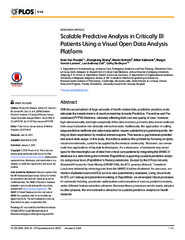Please use this identifier to cite or link to this item:
https://rfos.fon.bg.ac.rs/handle/123456789/1548Full metadata record
| DC Field | Value | Language |
|---|---|---|
| dc.creator | Van Poucke, Sven | |
| dc.creator | Zhang, Zhongheng | |
| dc.creator | Schmitz, Martin | |
| dc.creator | Vukićević, Milan | |
| dc.creator | Vander Laenen, Margot | |
| dc.creator | Celi, Leo Anthony | |
| dc.creator | De Deyne, Cathy | |
| dc.date.accessioned | 2023-05-12T11:01:52Z | - |
| dc.date.available | 2023-05-12T11:01:52Z | - |
| dc.date.issued | 2016 | |
| dc.identifier.issn | 1932-6203 | |
| dc.identifier.uri | https://rfos.fon.bg.ac.rs/handle/123456789/1548 | - |
| dc.description.abstract | With the accumulation of large amounts of health related data, predictive analytics could stimulate the transformation of reactive medicine towards Predictive, Preventive and Personalized (PPPM) Medicine, ultimately affecting both cost and quality of care. However, high-dimensionality and high-complexity of the data involved, prevents data-driven methods from easy translation into clinically relevant models. Additionally, the application of cutting edge predictive methods and data manipulation require substantial programming skills, limiting its direct exploitation by medical domain experts. This leaves a gap between potential and actual data usage. In this study, the authors address this problem by focusing on open, visual environments, suited to be applied by the medical community. Moreover, we review code free applications of big data technologies. As a showcase, a framework was developed for the meaningful use of data from critical care patients by integrating the MIMIC-II database in a data mining environment (RapidMiner) supporting scalable predictive analytics using visual tools (RapidMiner's Radoop extension). Guided by the CRoss-Industry Standard Process for Data Mining (CRISP-DM), the ETL process (Extract, Transform, Load) was initiated by retrieving data from the MIMIC-II tables of interest. As use case, correlation of platelet count and ICU survival was quantitatively assessed. Using visual tools for ETL on Hadoop and predictive modeling in RapidMiner, we developed robust processes for automatic building, parameter optimization and evaluation of various predictive models, under different feature selection schemes. Because these processes can be easily adopted in other projects, this environment is attractive for scalable predictive analytics in health research. | en |
| dc.publisher | Public Library Science, San Francisco | |
| dc.relation | National Institutes of Health (NIH) through National Institute of Biomedical Imaging and Bioengineering [R01 EB01720501A1] | |
| dc.relation | Vancis B.V. (Amsterdam, NL) | |
| dc.relation | Xomnia B.V. (Amsterdam, NL) | |
| dc.relation | RapidMiner | |
| dc.rights | openAccess | |
| dc.rights.uri | https://creativecommons.org/licenses/by/4.0/ | |
| dc.source | PLoS One | |
| dc.title | Scalable Predictive Analysis in Critically Ill Patients Using a Visual Open Data Analysis Platform | en |
| dc.type | article | |
| dc.rights.license | BY | |
| dc.citation.issue | 1 | |
| dc.citation.other | 11(1): - | |
| dc.citation.rank | M21 | |
| dc.citation.volume | 11 | |
| dc.identifier.doi | 10.1371/journal.pone.0145791 | |
| dc.identifier.fulltext | http://prototype2.rcub.bg.ac.rs/bitstream/id/316/1544.pdf | |
| dc.identifier.pmid | 26731286 | |
| dc.identifier.rcub | conv_1779 | |
| dc.identifier.scopus | 2-s2.0-84953931466 | |
| dc.identifier.wos | 000367801400054 | |
| dc.type.version | publishedVersion | |
| item.cerifentitytype | Publications | - |
| item.fulltext | With Fulltext | - |
| item.grantfulltext | open | - |
| item.openairetype | article | - |
| item.openairecristype | http://purl.org/coar/resource_type/c_18cf | - |
| Appears in Collections: | Radovi istraživača / Researchers’ publications | |
This item is licensed under a Creative Commons License


